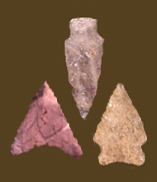|
CLAGETT
 Defining Attributes Defining Attributes
The Clagett point is long and narrow, and is thick in cross section. It has pronounced shoulders and an expanded stem. The base is usually straight or slightly concave.
.jpg)
Chronology
The Clagett point has not been well-dated, and no reported radiocarbon dates are associated with it. Stephenson and Ferguson (1963) link it with the Bare Island point in their type description of the Clagett. Alternatively, LeeDecker and Koldehoff (1991) suggest that the Clagett could be a large quartzite variant of Halifax/Vernon points (and also note similarities to the Brewerton/Otter Creek complex), and therefore speculate a radiocarbon date range of 3000-2000 BC (approximately 3700-2450 BC in calendar years). Steponaitis (1986) suggests a date range of c. 2500 to 1700 BC (approximately 3200-2050 BC calendar years), while Hranicky (2002) uses 1700 to 1300 BC (roughly 2050-1450 BC calendar). Dent (1995) also places it in the Late Archaic period, but the Virginia Department of Historic Resources (www.dhr.virginia.gov) assigns it to the Middle Archaic, at 4000 to 3000 BC.
Description
Blade: The blade, which is sometimes slightly beveled, is typically an elongated triangle with straight or slightly excurvate edges, prominent shoulders, a sharp tip, and a thick, lenticular cross section.
Haft Element: The base is straight or slightly concave, although a few are slightly convex. The stem constricts sharply from the shoulders to the midpoint of the stem, and then expands to a wide base. The stem is wider than it is long, and comprises 15% to 20% of the point’s total length.
Size: Length ranges from 43 to 89 mm, with an average of 65 mm. Width ranges from 15 to 29 mm, with an average of 22 mm. Thickness ranges from 6 to 13 mm, with an average of 10 mm.
Technique of manufacture: Moderately well-made by percussion flaking.
Material: In the area surrounding Zekiah Swamp on the lower Potomac, Wanser (1982) found that 69% of 32 Clagett points were quartzite, with 25% quartz and 6% rhyolite. At the Indian Creek V site in Prince Georges County, 86% of the 14 Clagett points were quartzite, followed by quartz (7%) and rhyolite (7%), and at the Accokeek Creek site in the same county, the points were “typically” quartzite, but quartz and argillite examples occurred (Stephenson and Ferguson 1963; LeeDecker and Koldehoff 1991). In the middle Potomac River Valley, quartz and quartzite are used (Hranicky 2002).
Discussion
Stephenson and Ferguson (1963) thought that the Clagett and Bare Island points were closely related, with the essential difference being that the former has an expanded stem rather than a straight stem. They also noted a resemblance to the Orient Fishtail. Clagett points are also similar in shape to -- but longer than -- Halifax points (LeeDecker and Koldehoff 1991). To a lesser extent, the Clagett point resembles the Otter Creek type and the Big Sandy II type from Tennessee. Otter Creek and Big Sandy points, however, typically have broader blades, well-defined notches, and squared-off, wide bases, while the Clagett is narrower and has a more generalized expanded base.
Defined in Literature
The Clagett was originally defined by Stephenson and Ferguson (1963), based on 236 points recovered from the Accokeek Creek site in Maryland. They acknowledged that Kinsey (1959) described a similar point in his discussion of points from Bare Island in the Susquehanna River, and that Holland’s (1955) Type I in Virginia is somewhat similar to Clagett.
References
Dent 1995;
Holland 1955;
Hranicky 2002;
Kinsey 1959 ;
LeeDecker and Koldehoff 1991;
Ritchie 1971;
Stephenson and Ferguson 1963;
Steponaitis 1986; Wanser 1982 |

![]()



 Defining Attributes
Defining Attributes